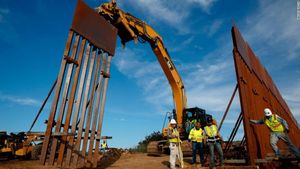The Indian Space Research Organisation, or ISRO, is making substantial strides toward cementing India’s position as a key player in global space exploration. With the nation celebrating its advancements, the developments surrounding the upcoming Gaganyaan mission and the successful missions like Chandrayaan-3 underscore this ambition.
On August 23, 2023, India marked history by landing its Chandrayaan-3 spacecraft on the Moon’s south pole. This achievement not only made India the fourth country to reach the Moon but also highlighted the extraordinary scientific and engineering capabilities of the ISRO.
Prime Minister Narendra Modi celebrated this remarkable feat, stating, "India is on the Moon! We have our national pride placed on the Moon!" This moment reflects the nation’s growing confidence and expertise as it steps firmly onto the global stage of space exploration.
The date of the Chandrayaan-3 landing is now recognized annually as National Space Day, celebrated across the country with various activities to engage citizens. Dr. S. Somanath, Chairman of ISRO, has invited citizens to step forward and celebrate the advancements of Indian space missions.
The Gaganyaan mission is poised to be India’s first crewed spaceflight initiative, aiming to send Indian astronauts—referred to as "Gagannauts"—to low Earth orbit. The first test flight of the crewed rocket is scheduled for December 2024, following extensive training of astronaut candidates.
Four astronauts have been selected for this ambitious project, each undergoing rigorous training at the Yuri Gagarin Cosmonaut Training Center. Training includes simulated space conditions, enabling them to prepare for the physical and mental demands of space travel.
ISRO shared engaging video footage from the training exercises, illustrating how candidates adapt to microgravity and experience rocket-launch simulations. Their year-and-a-half training program emphasizes the importance of teamwork and communication skills.
Following their remarkable efforts, two of the astronauts will have their first spaceflight earlier than the crewed Gaganyaan mission. Group Captain Shubhanshu Shukla will participate as the primary astronaut for Axiom Space’s Ax-4 mission, targeting launch for late 2025.
Meanwhile, ISRO continues to work on its rockets and launch vehicles to support burgeoning space missions. The Small Satellite Launch Vehicle (SSLV) is one of the projects gaining traction, indicating ISRO's intent to commercialize small satellite launches.
The SSLV will allow for rapid deployment of small payloads and is anticipated to play various roles, from government to commercial missions. The simple design of the vehicle prioritizes the ease of manufacturing, indicating ISRO's vision for collaborative growth with private space ventures.
Beyond the SSLV and Gaganyaan, India’s endeavors extend to scientific missions exploring cosmic phenomena. The Aditya-L1 mission, launched to observe the Sun, is set for integrated findings pertinent to solar-terrestrial interactions, impacting life on Earth.
Chandrayaan-3’s success has invigorated the Indian space sector, inspiring startups and collaborators to pour resources and creativity toward spatial exploration. Notable figures like Nambi Narayanan have highlighted how this achievement encourages budding companies to innovate within the space industry.
India's advancements resonate far beyond outer space; they impact daily life through technology derived from satellite data. Innovations influenced by this data assist with natural disaster management, agriculture assessments, and urban planning across the nation.
The foundation for these developments rests on the vision of pioneers like Dr. Vikram Sarabhai, whose early work established the groundwork of ISRO. His conviction of space technology for societal benefit set India’s space mission along its current path.
From launching its first satellite Aryabhata aboard Soviet rockets to now developing indigenous vehicles like the PSLV, India's progress illustrates its firm determination to lead within the global space community. The PSLV project, which has steadily seen success since its first launch, carries both domestic and international payloads, enhancing ISRO's global reputation.
Many milestones define India's march toward becoming a recognized space power. For example, the Mars Orbiter Mission propelled India to notable heights, as India became the first Asian nation to reach Mars orbit.
This achievement came at remarkably low costs, showcasing not only ISRO’s efficiency but its determination to redefine the metrics for successful space missions. NASA administrator Charles Bolden lauded the Mangalyaan mission as “a triumph for low-cost space exploration.”
India's timeline of advancements clearly depicts its evolution from modest beginnings to becoming one of the world’s leading space-faring nations. Chandrayaan-3 and the upcoming Gaganyaan exemplify this rapid progression, solidifying India’s standing among international powers.
The future is bright with upcoming endeavors like the XpoSat—India’s first dedicated polarimetry mission to study cosmic X-rays from celestial phenomena. All these missions collectively push India to the forefront of space research, contributing vast knowledge to the scientific community.
The aim of XpoSat transcends mere observation; it aims to unravel the nature of fringe phenomena involved with neutron stars and black holes. With each new project, ISRO not only enhances its technical prowess but also gathers interest and curiosity among young students to discover careers within science and technology.
ISRO’s commitment to nurturing talent through initiatives, workshops, and outreach has placed thousands of young minds along the path of exploration and innovation. Space science drew notable interest during the development of the Aditya-L1 mission, sparking conversations on research and possibilities within the solar system.
With engaging public events like the recent space exhibition held by ISRO at Kanakakkunnu, the focus remains on involving citizens directly with advancements. The exhibition reflects on the past, present, and future of India's space odyssey, generating significant intrigue and enthusiasm.
The overarching theme, “Touching lives whilst touching the Moon: India’s space saga,” perfectly embodies the essence of the accomplishments portrayed during the exhibition. With elements such as lunar origins, virtual simulations, and models of spacecraft, the celebration illustrates the benefits and aspirations behind the nation’s missions.
Thus, the transformation of India from aspiring to achieving significant milestones showcases the resolve of ISRO and the nation. With continued cooperation between government, private sectors, and academia, the nations' space ambitions will only grow more vibrant.
From science to technology, the impact of ISRO’s missions resonates broadly, establishing pathways for many future opportunities. With every carefully curated mission launched, India writes its story within the cosmic theatre, aspiring for exploration beyond the stars.



